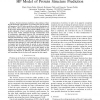146 search results - page 1 / 30 » Evolutionary design of the energy function for protein struc... |
CEC
2009
IEEE
13 years 11 months ago
2009
IEEE
— Automatic protein structure predictors use the notion of energy to guide the search towards good candidate structures. The energy functions used by the state-of-the-art predict...
CEC
2011
IEEE
12 years 4 months ago
2011
IEEE
Abstract—Protein structure prediction is the problem of finding the functional conformation of a protein given only its amino uence. The HP lattice model is an abstract formulat...
BMCBI
2008
13 years 4 months ago
2008
Background: Residue depth allows determining how deeply a given residue is buried, in contrast to the solvent accessibility that differentiates between buried and solvent-exposed ...
BIBM
2010
IEEE
13 years 2 months ago
2010
IEEE
ATP is a ubiquitous nucleotide that provides energy for cellular activities, catalyzes chemical reactions, and is involved in cellular signaling. The knowledge of the ATPprotein in...
GECCO
2005
Springer
13 years 10 months ago
2005
Springer
The prediction of the native structures of proteins, the socalled protein folding problem, is a NP hard multi-minima optimization problem for which to date no routine solutions ex...


